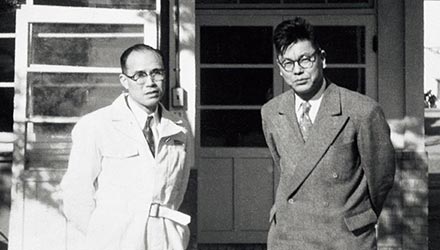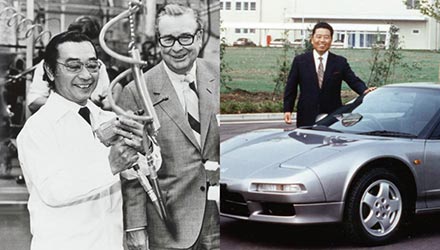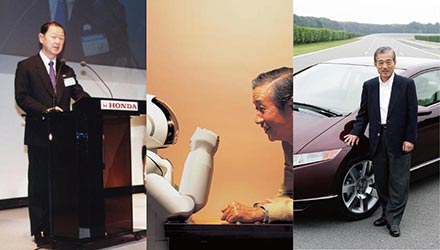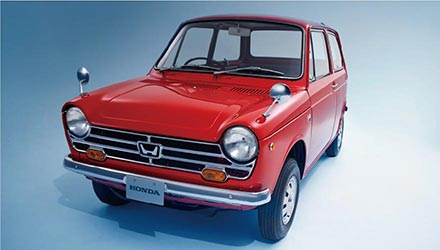Amid Headwinds, The Last Domestic Entrant
into the Japanese Market
Having established a solid global position in motorcycles, Honda was planning its next foray into the automobile market. In May 1961, the company found itself in a tight spot when the Ministry of International Trade and Industry (MITI) proposed a bill on Temporary Measures to Stimulate Specific Industries, which was designed to consolidate automakers and restrict new entrants in order to strengthen Japan’s international competitiveness.
Despite rapid development, Honda was able to exhibit the SPORTS360 / SPORTS500 (later launched under the product name of S500) and the T360 mini-truck at the 9th All Japan Motor Show in October 1962. Honda made its debut as Japan’s last domestic automaker the following year.
Carrying the Torch with Our Own Hands
To cultivate a market for its automobile products, Honda needed to build a sales network. In 1963, the company recruited from among its motorcycle dealers in Japan who were willing (and able) to handle automobile sales, and designated them as its initial auto dealers. Wholesale distribution of Honda automobile products was then targeted to motorcycle dealers wishing to sell automobiles. As such, when Honda entered the automobile market, there were no dealers specializing in automobile sales; dealers sold both motorcycles and automobiles.
Honda began organizing its automobile dealers, first in Tokyo, and more than 1,200 shops in the metropolitan area alone began sales of Honda automobile products as authorized AHSSA*1 dealers.
A direct sales system, also known as the “Toyota system,” in which wholesalers and retailers are integrated, was common at the time. On the other hand, Honda introduced a wholesale system and established a clear division of roles, with distributors and Honda sales offices focusing on wholesale, and dealers throughout Japan purchasing vehicles from distributors and Honda sales offices and selling them to customers.

AHSSA dealership
However, Honda motorcycle dealerships at that time had the advantage of being close to the local community, they were too small to sell automobiles, and many of them were not equipped to service automobiles; therefore, after sales service and repairs were performed mainly by Honda distributors. In many cases, even Honda distributors did not have sufficient capability to perform the repair, thus the vehicle had to be brought into independent repair shops. In addition, the DOHC engine, which was revolutionary at the time, was shunned by repair shops due to the difficulty in servicing it.
To address such issues, in 1963, Honda began building a nationwide network of its own service and repair facilities based on the All Honda Service Factory (AHSF) concept. In February 1963, the first Honda-SF (Honda Service Factory) was established in Shirako, Saitama Prefecture, quickly followed by the establishment of more Honda-SF facilities throughout Japan, including Oshiage, Sapporo, Natori, Neyagawa, Fukuoka, and other locations.
Honda also introduced the industry's first*2 long-term warranty system, which provided a two-year, 50,000km warranty on all new motorcycle and automobile models. This system was designed to promote Honda vehicles as high performance, yet durable and reliable, generating peace of mind for buyers and sellers of Honda products. The pursuit of performance and quality was a strategy to outperform the leading manufacturers, and it was the company’s main goal.

Honda SF (around 1973)

Honda SR
The bill on Temporary Measures to Stimulate Specific Industries that had been submitted to the Diet was scrapped and, as a result, Honda was able to enter the domestic automobile market in earnest, and began its own path rather than following others, based on the idea of “carrying our own torch” in creating technology, products, and sales structure.
In October 1965, Honda opened its first showroom (Honda SR) as a business meeting venue for AHSSA dealers in its Tokyo branch in Ikebukuro. In April 1966, Honda established Honda Sales Research Co., Ltd. to study various sales issues and reflect them to sales policies, as well as to understand the demand in the automobile market. This was a measure based on the Honda “Three Reality Principle,” where Honda itself learned the ideal direction of automobile sales from the front line to support dealers who had just started up and did not have expertise in automobile sales. At the same time, Honda Shinpan Co., Ltd. (consumer credit company) was established in anticipation of the spread of automobile loans, uncommon at the time, and Honda Used Car Sales Co., Ltd., was created to strengthen sales capabilities through trade-ins. In December of that year, Honda established 12 automobile sales offices nationwide, and quickly established a system to support sales at retail outlets.
- All Honda Service Shop Association
- One-year, 20,000 km warranties were standard at the time. It was also the longest warranty among Japanese manufacturers, exceeding the two-year, 38,000 km warranty offered by Ford and GM (Honda internal research).
Price Guessing Quiz
For the market launch of the S500, among other publicity measures, Honda created a buzz by conducting the “SPORTS500 Price Guessing Quiz*3”. It was a strategy proposed by Takeo Fujisawa based on his belief that advertising and public relations were an effective measure for sales and marketing when launching products into an untapped market.

- The SPORTS500 Price Guessing Quiz was posted on 16 newspapers in Japan coinciding with the launch of S500 in 1963, creating a buzz that resulted in a total of 5,735,417 responses.
Honda Carries the Torch with Its Own Hands
“Honda is a company that carries the torch with our own hands. Many Japanese automobile companies tend to follow the bright lights of those ahead of them. Even if it is a small torch, Honda is a company that makes its own torch, carries it with its own hands, and moves forward in different directions from those of others.”
(Takeo Fujisawa speech, December 1967)
Separating Wholesale and Retail
At the time, the mainstream method of automobile sales in Japan was direct sales, where wholesale and retail were integrated. Automobile manufacturers sold their vehicles directly to large-scale dealers, who would then sell them to customers.
However, Honda prohibited its distributors and sales offices from selling products directly to customers, but allowed them only to wholesale to retail shops (dealers) that would sell products to customers. This unique system was an effective method to fully utilize the sales capability of dealers by protecting their profits through the separation of wholesale and retail.
Striving to be a Socially Responsible Company
as the No.1 K-car Manufacturer
 N360
N360
In 1967, Honda launched its first K-car model, the N360, and within two months it became the top-selling model in Japan. The N360 combined high performance and a spacious interior with a drastically low price, and with the completion of the Suzuka Factory in October, a mass production system was established. In June the following year, Honda announced the introduction of the Honda Specialty Store system. In 1969, in an industry where it was commonplace for K-cars from multiple manufacturers to be sold at the same venue, Honda started the
Ⓐ (Maruei) Store system exclusively for Honda K-cars, creating a network of 856 Ⓐ stores. In automobile sales, Honda yet again chose the path of independence and self-reliance.
The N series*4, including N360-derived models, exceeded 500,000 units within 26 months of its launch. However, in 1969, claims broke out about Honda cars being defective. Although they were unfounded claims, it caused significant damage, including a decline in sales. To overcome this challenge, Honda became the first automaker to take on social responsibility as a company. In 1970, Honda began a 100% routine inspection campaign, and in the same year, launched the Traffic Safety Promotion Operations and Pollution Control Center. Honda also joined the ESV (Experimental Safety Vehicle) Project, and in 1974, established the International Association for Traffic Safety.
In 1971, the company launched the Life K-car model with a water-cooled engine. Designed with environmental responsibility in mind, it won the Car of the Year*5 award in the K-car category that year. This success led to the development of the Civic.
- N360, N600, LN360 and TN360
- “Car of the Year” award by Motor Fan magazine, which was later succeeded by the “Japan Car of the Year” in 1980.

Civic CVCC equipped with the CVCC engine that met the U.S. Clean Air Act of 1970 (known as the Muskie Act) standards.
Offering Cars that Meet the Customer Needs of the Times:
Shifting to Small Car Sales
In 1969, Honda launched the four-door H1300 sedan, marking its beginnings as a small passenger car manufacturer, followed by the introduction of another small car model, the Civic. With a strong will to meet customer demands and expectations, Honda made dramatic advances in product quality in a short period of time. At the same time, in order to deliver excellent new products to as many customers as possible, Honda evolved its sales system aiming to expand the “Joy of Buying” for more customers.
In the 1970s, while automobiles became more affordable leading to the development of traffic networks, this also brought more pollution, traffic accidents, and energy problems. In 1970, the U.S. Clean Air Act of 1970, the world's most stringent environmental regulation, was enacted in the U.S. mandating that emissions of carbon monoxide (CO), hydrocarbons (HC), and nitrogen oxides (NOx) be reduced to less than one-tenth of their former levels. In October 1972, Honda announced the CVCC engine, the world’s first engine that met these standards without use of a catalytic converter and, in December 1973, the Civic CVCC was launched.
The Civic series, which satisfied societal needs for comfort, safety, and environmental performance, won the Car of the Year award (sponsored by “Motor Fan” magazine) for three consecutive years from its debut in 1972.
With the first oil crisis and global energy issues becoming more serious, the Civic, with its low fuel consumption and low emissions, became the car the times demanded. Honda started an automobile dealership system fully equipped with showrooms and maintenance shops, a customer management system, and a sales plan. Honda also launched a compact dealership system in conjunction with the launch of the Civic, steadily building a sales structure tailored to customer needs.

Civic wins Car of the Year award (sponsored by the “Motor Fan” magazine) for three
consecutive years
Pursuing Customer Satisfaction with SED Development System
and Aiming to Launch Full-Fledged Automobile Dealerships
With a boost from the global preference for compact cars, in July 1976, four years after its launch, the Civic reached cumulative production volume of 1 million units. In May, a new compact car, the Accord, a hatchback with a CVCC engine, was launched catering to new lifestyles including the spread of the two-day weekend and the development of an expressway network in Japan. The SED Development System*6 introduced during Accord development would become the foundation for later hits such as the City and Prelude.
Despite the market launch of the Accord, small car sales in Japan were sluggish. To leverage sluggish sales, Honda announced the “Ⓔ Plan,” to enhance the capabilities of the sales force and dealerships and to cultivate more customers.” As part of this plan, Honda strengthened its existing authorized dealerships, improved its after-sales service and used car sales system and capability, and built new dealership locations in underserved areas all across Japan.
To further expand sales volume, Honda launched the Verno dealership channel in 1978, exclusively selling the Prelude, a personal specialty car (sports model). Verno was the first attempt by Honda to strategically plan store openings. The company’s sales network was no longer limited to motorcycle dealers turned auto retailers, but began to become a full-fledged automobile dealership network. Furthermore, in 1981, Domestic Automobile Operations was established to focus the entire organization and Honda associates on satisfying customers.
The City, created by a development team with an average age of 27, launched in 1981, and was the catalyst Honda needed. It was an immediate explosive hit, attracting young customers. Honda automobile unit sales in Japan reached 330,000 units, a significant increase from 270,000 units in the previous year. It was the first time in 11 years that Honda automobile sales in Japan recovered to the level above the 300,000-unit mark.
- For more details, see Chapter IV Business Foundation Initiatives “SED Development System”

Honda City
Revamping the Sales Network into Three Channels

Third-generation Prelude
Following the sporty and individualistic Verno channel, the luxurious Clio channel was launched in 1984, followed by the family-oriented Primo channel in 1985, increasing Honda sales channels to three. In 1985, the Legend, the Honda flagship*7 and its first “3-number” (Japanese classification for private vehicles with 2L or larger displacement) model, was launched exclusively through Clio dealers, while the first Honda K-car model, the Today, was launched through the Primo channel. In 1987, the third generation Prelude was launched through Verno dealers, and its revolutionary 4WS*8 technology made such an impact that a clear distinction between the three channels system was established. Honda also began its own CSI survey*9.
In 1988, Honda imported and sold the Accord Coupe manufactured at its auto plant in Ohio, USA, becoming the first Japanese automaker to break with the tradition of manufacturing in Japan and exporting its products.

Primo dealership

Clio dealership

Verno dealership
- A model positioned at the top of the product lineup and becomes the face of the company
- The world’s first steering angle sensing 4WS (four-wheel steering) system (Honda internal research)
- Customer Satisfaction Index: The index of users’ satisfaction level with car quality and after-sales service one year after the purchase. In the U.S., J.D. Power & Associates conducted a CSI survey of all automakers. Since it was not conducted in Japan at that time, Honda started its own CSI survey, clearly demonstrating the company’s desire to always incorporate customer opinions.

Accord Coupe
Demonstrating the Collective Strength of “All Honda” to
Overcome Recession After the Economic Bubble Burst
In 1990, when the NSX and second-generation Legend / Legend Coupe were launched (the Coupe began sales in 1991), Honda announced its fourth mid-term plan under the slogan “Simplicity, Concentration, Speed,” and began full-scale efforts to strengthen its domestic automobile business, centering on strengthening sales. At the time, metropolitan areas*10 accounted for 47% of the nation’s overall automobile market. However, the composition of Honda sales in metropolitan areas was only 39%. In order to strengthen sales in this critical area, a large number of associates from the domestic automobile operations were transferred or dispatched*11 to Honda sales companies in metropolitan areas.
In 1991, Honda introduced the Beat, and the U.S.-made Accord Wagon and added a new type of the U.S.-made Accord Coupe, but domestic automobile sales were stagnant due to the economic recession that signaled the collapse of the bubble economy. At the time, the Japanese market was in the midst of an unprecedented RV*12 boom. Honda, which had no RVs of its own, sold OEM vehicles*13 from Chrysler, Rover, and Isuzu, but its momentum in the Japanese market was weakening.
In February 1993, Riku Iwai was appointed General Manager in charge of sales and marketing for Domestic Automobile Operations. In order to complete the “transformation to a highly effective and efficient corporate structure,” as stated in the 5th mid-term plan, he worked on the sales side to provide products and services with top-class appeal in the areas of Q, C, and D*14. After assuming the position, Iwai spent about a month at R&D, observing the process in detail, and as a sales representative, worked to promote the creation of “Market-In”*15 products so that market needs could be further reflected to product development.
In 1994, Honda further developed its strategy of “building products close to the customer” aimed at globalization, and set out to achieve autonomy in its four regions. Progress was made in each of its regional headquarters (the Americas, Europe, Asia & Oceania, and Japan) becoming self-reliant. In Japan, however, the appreciation of the yen and the expansion of local production led to a decline in exports, which, combined with sluggish domestic sales, resulted in a 26% decline in domestic vehicle sales (approximately 500,000 units) from the peak in 1990. Securing domestic automobile sales of 800,000 units became an essential proposition for the independence of Regional Operations (Japan).
Creative Mover series

Odyssey

CR-V

Step WGN

S-MX
A breakthrough came with the Odyssey, which was developed with a “market-in” mindset. The Odyssey, the prototype of Honda unique minivans, was the first of the Creative Mover series*16 and was a huge success.
In 1995, Honda launched the “800K Plan,” a plan to establish an automobile sales operation capable of selling 800,000 units annually in Japan. The primary target of this plan was to enhance product appeal, strengthen sales and service capabilities, consolidate sales offices and broaden their respective areas of responsibility, and increase cost competitiveness. Many associates, not only from sales divisions but also other divisions, were assigned to the forefront of sales operations.
The development and production teams responded to the challenge of creating a product lineup that exceeded customer expectations in one swoop, with the sales force pulling out all the stops to deliver the “Joy of Buying” to as many customers as possible. In 1996, sales in Japan reached a record high of 761,784 units, due largely to a significant increase in sales of the Creative Mover series models, namely StepWGN, CR-V and S-MX, which followed the success of the Odyssey.
In 1997, Honda automobile sales in Japan reached the 800,000 unit target. As a result of the concerted efforts of the entire company, automobile business in Japan achieved a V-shaped recovery. Moreover, for the fiscal year ended March 1997, Honda achieved then record high consolidated profit.
In 1998, Honda began to build a solid automobile sales system to consistently sell 800,000 units in Japan, with a determination to respond more precisely to changes in society and customer needs. It was a challenge Honda took on to maintain its stable ties with customers.
- Honda collectively referred to the Tokyo Metropolitan area (Tokyo, Kanagawa, Chiba, Saitama), Chukyo area (Aichi, Shizuoka), and Kansai area (Osaka, Hyogo, Kyoto) as the “Metropolitan Area”
- Some associates were transferred or dispatched to other Honda companies starting in 1989.
- RV: Recreational Vehicle
- OEM: Original Equipment Manufacturers, selling products developed and manufactured by other companies under their own brand
- QCD: Quality, Cost competitiveness, Delivery
- Developing products reflecting customer opinions and requirements
- RV based on unique Honda concept of “Creative Mover”
Behind the Birth of the Odyssey
The Odyssey was developed under the slogan of “all occupants are a priority.”
Kunimichi Odagaki, LPL (Large Project Leader) recalled: “Although it was said to be the ’RV boom,’ when we looked around, there was no ‘recreational vehicle’ in the true sense. We wanted to create a vehicle that we could enjoy driving ourselves. All of our members were filled with such desire".
“We did the market research, driving around in Japan, North America and Europe in cars that we considered Odyssey’s competition. We listened to the voices of RV and minivan users, grasped the strengths and weaknesses of current products, and clarified what we wanted the car to be like. I felt more strongly than anyone else the need for Honda to introduce such a car to the world. I think the development of an uncharted car like this is necessary for the R&D Center on a regular basis, not only from a marketing standpoint, but also to prevent organizational rigidity and the rut of R&D.” With SED working together, backed up by strong allies throughout Honda, the Odyssey, Honda’s savior, was born.













